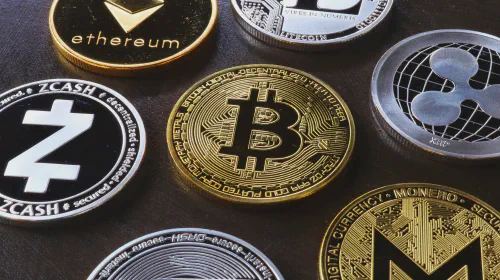How to View the Activity of a Bitcoin Address
Salomon Kisters
Jun 1, 2022This post may contain affiliate links. If you use these links to buy something we may earn a commission. Thanks!
A bitcoin address is an important location that allows users to exchange bitcoins with each other. Your bitcoin address is unique to our account and is required for sending and receiving bitcoins. Since the bitcoin blockchain is transparent, information about a Bitcoin address is available to the public.
Understanding how Bitcoin works can be used to trace transactions on the blockchain. In this article, we’ll guide you on how to check the activity of your bitcoin address so that you can monitor transactions across the blockchain. Before we get to that part, let’s cover the basics of a bitcoin address.
What is a Bitcoin Address?
A Bitcoin address is a unique, virtual location that indicates where Bitcoins can be sent. It is represented by an alphanumeric string of characters. The length of the address varies, but it is usually 26-35 characters long.
Your address is unlike a wallet, where you can store a balance of cryptocurrencies. The address is stored on the blockchain and is useful in verifying previous transactions. Bitcoin addresses are generated through Bitcoin wallets using cryptography.
Each address has two parts that are an asymmetric signature of each other: a public key and a private key.
- The public key is used to derive the Bitcoin address. The Bitcoin address can then be searched by anyone on the blockchain. Think of it as an email that is used to send regular currencies.
- The private key serves as a signature for the public key. It functions as a password for the complementary public key. For this reason, the private key must be kept secret.
The Bitcoin address-generating system automatically creates complementary pairs of keys. The keys can be anonymously signed by a user without revealing their true identity to anyone else on the blockchain.
To recap, here are some key points to remember about your Bitcoin address.
- It is a unique alphanumeric string of 26-62 characters that may start with different characters.
- It is used to send and receive Bitcoins. However, 2-way transactions only work for the same type of addresses
- It is often only temporary. Deterministic wallets use “master private keys” to derive multiple other private keys and Bitcoin addresses.
- It is often used only used for a single transaction. In that way, it functions like a consumable token.
- It cannot hold a balance. Therefore, it is not a wallet.
- It has two components: a public key and a private key.
- The private key is used as a signature for the public key when completing a transaction.
- The public key can be searched on the blockchain.
Types of Bitcoin Addresses
There are different types of Bitcoin addresses. Each address differs in some features added by improvements in technology standards. Newer address types are more efficient for conducting Bitcoin transactions but may not be compatible with older addresses. You should be aware of your address type as it can only send and receive transactions from the same address type.
The string that makes up the address starts with 1, 3, or other characters, depending on the address type.
Legacy Bitcoin Address Types
These are the earlier versions of Bitcoin addresses:
- P2PKH starts with the number 1
For example: 1BvBMSEstWetqTFn6gH7m4GFg7xJaNVN2
- P2SH (or legacy Segwit) starts with the number 3
For example: 3BvBMSEstWetqTFn6gH7m4GFg7xJaNVN2
Newer Bitcoin Address Types
These addresses are more efficient for processing Bitcoin transactions. They are represented by longer strings (between 42 and 62 characters).
- Bech32 Segwit starting with bc1q
For example bc1qj89046x7zv6pm4n00qgqp505nvljnfp6xfznyw
- Taproot Bech32m starting with bc1p
For example: bc1p8denc9m4sqe9hlyusrvxkkdqgkydrk5ctxre5nkk4qwdvefn0sdsc6eqxe
How Can I Check the Activity of a Bitcoin Address?
This record is always available on the blockchain. That means your transactions are still searchable in the database to anyone who can access it. This is a great way to look at specific addresses for checking the transaction activity through it.
In addition to all the users participating in the Bitcoin blockchain, the transactional database is maintained by several organizations that make tracking information easy to search. Examples of tracking organizations include Blockchain Explorer, BitRef, and Blockonomics.
Here is a step-by-step guide to looking for transactions linked to a specific bitcoin address. We are using Blockchain Explorer as an example. You can also search the information on other websites that you may find easier to use.
1. Visit the website and type (or copy-paste) the Bitcoin address of your choice in the search bar. This is the first step. You just need to know the address of your interest.
2. The search query will show the complete list of Bitcoin transactions linked to that address. You can see several transaction details associated with the Bitcoin address. The details include the address type, the total number of transactions, total Bitcoins sent and received, transacting addresses, and the final balance.
A list of all the associated transactions will also be given. Here are the transaction details that are shown in the search results.
Date and Time Stamps
Date and time stamps show the exact date and time the Bitcoin transactions were completed.
Transaction Amounts
The amount of Bitcoins sent to and from the address is listed. These may be color-coded or represented by symbols. Transaction amounts can be viewed in bitcoins or fiat currency equivalents.
Transaction Fee
The transaction fee is the amount paid to process the transaction. It is accompanied by information about the virtual bytes transferred in the transaction.
Hashes
These are identifiers that are used to publicly identify the transaction. They are alphanumeric character strings.
Bitcoin Addresses
The list of addresses involved in each transaction is displayed. Addresses are clickable links, and clicking on a link jumps to a search query of the corresponding address in the database. In this way, you can search for addresses linked to the one you initially searched for.
Some transactions can show multiple instances of cryptocurrencies exchanged. These transactions may involve several addresses.
3. Use the QR Code to Send or Request Funds
Blockchain Explorer displays a QR code specific to the bitcoin address, which can be used to send Bitcoins or to send a request for Bitcoins. Many Bitcoin wallets and trading apps come with QR code functionality to transfer Bitcoins.
Things to Know When Choosing a Site to Search for a Bitcoin Address
When using a bitcoin address search tool, it is worth knowing its features. Some websites, like BitRef, only display a limited number of transactions per address. So they may not be useful for gathering a complete history or looking up older transactions in the case of a frequently used address.
Other websites may not support newer types of bitcoin addresses.
Some sites have additional features such as multi-address search and wallet management services. It all depends on your preferences. We recommend picking any website you are comfortable with.
What is the Benefit of Checking the Activity of a Bitcoin Address?
Ok, so you know how to look up a particular Bitcoin address. But what is it really good for? There are some reasons why it’s a useful exercise.
Confirming Transactions
Bitcoin transactions can take some time. While you will normally receive a notification for a successful transaction in a short time, there are instances when that does not happen.
Checking the activity of an address is one way to confirm if a transaction has successfully completed and is logged in the blockchain. If you are worried about your transaction not getting through, this option might give you some peace of mind.
Identifying Suspicious Users
The Bitcoin network is notorious for being associated with illegal trading, often carried through the dark web. The transparency of the blockchain allows anyone to identify an address of a malicious user. From there, users can check all transactions made with that address.
Internet users can notify the relevant authorities and the general community to take the actions necessary to solve related problems. Consider the cases of the big 2015 Twitter hack or the conviction of the founder of Silk Road.
Sending and Receiving Bitcoin on the Go
If you have a laptop and travel frequently, you can technically use the database to fetch the QR code for an address. You can then use your mobile device to quickly send Bitcoins to the address of your choice. Just be careful to keep all your information – and your devices – secure.
Educating Others about Bitcoin
Alright, we are really stretching it now. But on a lighter note, showing and telling people who are new to the crypto world how a Bitcoin address works is very helpful. The database is also a neat way to inform others about the transparency of blockchain networks. Perhaps you might even convince them to join the Bitcoin fold!
How Do I Get a Bitcoin Address?
Getting your Bitcoin address is easy. All you need is a Bitcoin wallet app or an account with a Bitcoin exchange that offers a wallet service. Simply register an account to a wallet or Bitcoin exchange of your choice and use a seed to generate addresses.
We recommend using one address for every transaction to keep transaction details secure. There’s no need to worry about having multiple addresses, as your seed can easily generate many addresses. A Bitcoin wallet also conveniently keeps all your addresses in a single place.
Final thoughts
Bitcoin addresses may look confusing to someone new to cryptocurrencies, yet they are a fundamental part of what makes Bitcoin special. It’s easy to search a Bitcoin address to check the transaction activity. You can open a world of possibilities for yourself by starting Bitcoin trading with a newly generated address in the Bitcoin app of your choice.
If you are wondering whether you can integrate blockchain systems into your business, consider originstamp.com for safely and securely timestamping your processes. We provide a trusted cloud-based platform that provides secure, timestamped documentation. Call us and learn how to reduce risk exposure and increase trust while using Bitcoin blockchains.
Stay informed with the latest insights in Crypto, Blockchain, and Cyber-Security! Subscribe to our newsletter now to receive exclusive updates, expert analyses, and current developments directly to your inbox. Don't miss the opportunity to expand your knowledge and stay up-to-date.
Love what you're reading? Subscribe for top stories in Crypto, Blockchain, and Cyber-Security. Stay informed with exclusive updates.
Please note that the Content may have been generated with the Help of AI. The editorial content of OriginStamp AG does not constitute a recommendation for investment or purchase advice. In principle, an investment can also lead to a total loss. Therefore, please seek advice before making an investment decision.

Blockchain Confirmations: Understanding Their Importance
Blockchain confirmations are the number of blocks added after a transaction, ensuring its permanence and security on the blockchain.

Blockchain 1.0 vs. 2.0 vs. 3.0 - What's the Difference?
Blockchain is a disruptive technology that has been around for 40 years. But what's the difference between Blockchain 1.0, 2.0, and 3.0?

Top Reasons Why Your Bitcoin Transaction is Still Unconfirmed
If you've ever transferred cryptocurrency, then you probably have experienced a delay in the confirmation of your transactions. Why is that, and what can you do?
Protect your documents
Your gateway to unforgeable data. Imprint the authenticity of your information with our blockchain timestamp